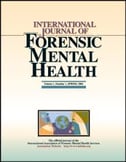 Casual attributions—judgments about the internal or external cause of an individual’s actions—influence scores on the HCR-20. This is the bottom line of a recently published article in International Journal of Forensic Mental Health. Below is a summary of the research and findings as well as a translation of this research into practice.
Casual attributions—judgments about the internal or external cause of an individual’s actions—influence scores on the HCR-20. This is the bottom line of a recently published article in International Journal of Forensic Mental Health. Below is a summary of the research and findings as well as a translation of this research into practice.
Featured Article | International Journal of Forensic Mental Health | 2014, Vol. 13, No. 1, 8-17
Investigating the Influence of Causal Attributions on Both the Worksheet and Checklist Versions of the HCR-20
Author
Abstract
Attribution theories suggest that when assessing an individual’s actions, judgments are made about the cause of these behaviours and often these judgments focus on internal or external causal explanations. The current research investigated the effects of internal and external attribution on the scoring of the HCR-20 and the possibility of differences in scoring between two ways of using the HCR-20 (using the HCR-20 as a worksheet versus checklist). No differences were present in the scoring between the checklist versus worksheet. Attribution effects were present within the Historical Scale, Clinical Scale, and overall scoring of the HCR-20. Ratings were higher within the internal attribution condition than the external one, indicating that judgments made using the HCR-20 are subject to attribution effects in a similar manner as unaided violence risk assessments.
Keywords
attribution, decision-making, clinical judgment, HCR-20, violence risk assessment
Summary of the Research
“Attribution theories posit that in order to understand the cause of our own or others’ behaviors, we will apply either an internal or an external explanation for the behaviour. When an internal cause is attributed to an individual’s behavior, such as personality or temperament, the individual is often considered to be in control of or responsible for their behavior. Conversely, when the cause of an individual’s behavior is attributed externally, for example, as a result of the environment, the behavior is considered to be less in the individual’s control and their level of responsibility for the outcome is therefore perceived to be low.
The current research aimed to investigate whether the HCR-20 would be affected by attribution effects [and] whether the way in which it is completed will affect the outcome of the risk assessment” (p. 8).
“The HCR-20 is one of the most widely researched, commonly used, and leading structured professional judgment (SPJ) violence risk assessment tools…SPJ tools, such as the HCR-20, do not aim to predict future violence, but instead aim to guide the clinician through the risk assessment using risk factors derived from both empirical and practice-based evidence and inform suitable risk management plans and interventions” (p. 9).
“The HCR-20 should be completed in conjunction with the HCR-20 manual and a ‘worksheet’ is often used to facilitate this. The worksheet guides the user in gathering information, to consider the presence and relevance of risk factors associated with the case, consider different hypothetical scenarios of violence (best-, most realistic-, worst-case scenarios), develop risk management strategies suitable to the case, and finally to document their summary judgments. Spaces are provided underneath each risk item where the clinician can provide evidence from the case sup- porting his or her assertions of whether the item is present, to what extent and whether its presence (or lack of) is of relevance to the risk assessment. In presenting and combining the evidence in this way, it is thought that decision making will potentially be less biased. However, not all clinicians use the worksheet in practice, or indeed the manual (this is not best practice, however, as the manual should be used to guide all assessments); the HCR-20 is at times used purely as a checklist, where the 20 factors are numerically coded on a 0–2 scale. In both the checklist and worksheet formats, the assessor should also formulate a final risk judgment indicating whether the person poses a low, moderate, or high risk” (p. 10).
“Attribution bias occurs when judgments are made about a person or situation but greater or lesser weight is placed on internal or external factors, skewing the viewpoint formed…When information relating to an individual’s internal state, such as mood or personality, is focused upon, internal causal theories about their behavior tend to be formed (internal attribution) and their actions are attributed on something internal to that person. If, on the other hand, external or situational factors are focused on, the individual’s behavior is attributed to something external to them and outside of their control (external attribution)” (p. 10).
Studies on attribution have “found that individuals whose behavior was described to imply more control over their actions (i.e., internally attributed) were considered more dangerous and to have committed a more serious crime than when the individual was described to emphasize the role of external factors on their behavior (i.e., externally attributed), despite the description of the crimes and key features of the individual remaining constant across the internal/external conditions. In order to investigate these attribution effects in relation to more modern risk assessment practice, it is crucial to identify whether attributionally manipulated in- formation influences the scoring of SPJ tools, such as the HCR-20, or whether this effect is confined to unaided clinical judgments” (p. 11).
“The current research [aimed] to investigate the effects of internally and externally manipulated attributional information on the scoring of the HCR-20, and whether this differs across completing the HCR-20 as a checklist or using the worksheet format… A 2×2 independent groups design was used, with the independent variables being the two modes of completion for the HCR-20 (checklist versus worksheet) and the two attributionally manipulated crime-based scenarios (internal versus external). The dependent variable was the numeric responses to the items measured on the HCR-20” (p. 11).
Participants were 40 master’s level psychology students who had an average of 17.5 years of education.
“A significant main effect of attributional manipulation was found for the Historical scale, the Clinical scale, and for the overall scoring of the HCR-20…Participants scored the offender significantly higher in the internal manipulation than in the external one for the Historical and Clinical scales and for the overall HCR-20 score. No main effect of attribution was found in the scoring of the Risk Management scale” (p. 13).
“No main effect of the ‘version’ of the HCR-20 used (checklist versus worksheet) was apparent in any of the three scales or the overall HCR-20 score, indicating no differences” (p. 13).
Differences across attributional manipulations appeared to be most prominent for the following items: Previous Violence, Substance Use Problems, Psychopathy, and Personality Disorder on the Historical scale; Negative Attitudes and Unresponsiveness to Treatment on the Clinical scale; and Exposure to Destabilizers on the Risk Management scale.
Translating Research into Practice
“The finding that individuals completing the HCR-20 as a checklist rated the offender to be a ‘high risk’ more often in the internal manipulation than in the external one provides further evidence that attribution influences assessments of violence. These findings are of paramount importance as they highlight that even when using an SPJ tool, judgments can still be affected by attribution bias.
The current findings identified a number of areas where attribution effects may be more present within the HCR-20; both in terms of scale level and item level. As the HCR-20 is divided into three scales (Historical, Clinical, and Risk Management) the scales most affected by attribution can be identified. Attribution effects were present in the Historical and Clinical scales, but not in the Risk Management scale. In both of the affected scales, numerical judgments of risk were higher in the internal manipulation than in the external one” (p. 15).
In terms of item-level differences in attribution-related scoring, it is important for clinicians to be aware of those items in which attribution effects are most prominent (i.e., Previous Violence, Substance Use Problems, Psychopathy, Personality Disorder, Negative Attitudes, Unresponsiveness to Treatment, and Exposure to Destabilizers) so that they might be mindful of these as a means of reducing attribution effects on these items and the overall judgment of risk that is made. Bearing these attribution effects in mind will help clinicians improve their decision making and risk formulation using the HCR-20.
“The current findings further indicate that the scoring of the HCR-20 does not differ as a function of the checklist versus worksheet modes of completion. This finding is encouraging in terms of applying the findings of existing research, which utilized the HCR-20 as a checklist, to clinical practice…In addition, the present findings support and strengthen those of earlier research findings in the area, in that internally manipulated scenarios are rated higher in terms of risk than externally manipulated ones. Thus, attribution effects are not confined to only unaided judgments of violence risk assessment, but apply also to those made using SPJ tools” (p. 16).
Other Interesting Tidbits for Researchers and Clinicians
“These findings, however, should be considered with caution as it is clear that the effect size, and therefore practical significance/magnitude, of the findings are small. The statistical significance should therefore be considered with some tentative appraisal when discussing the magnitude of this finding, and the overall strength of meaning behind it. Indeed, future research should investigate various levels of clinical expertise and use various vignettes in order to assess the robustness of these findings; ideally with larger sample sizes. However, the current findings could be viewed as a first step towards systematically investigating the effect of known decision-making biases and errors on the completion of the HCR-20” (p. 15).
“Concerning the scoring of the HCR-20 when used as a check-list compared to the worksheet, no significant differences were found. This would appear to be a positive indication for the applicability of existing research (which largely utilizes the HCR-20 as a checklist) to practice, where it is the fuller worksheet adjunct to the HCR-20 manual that should be used. It can therefore be proposed that existing research investigating the HCR-20 is indeed applicable and generalizable to practice” (p. 16).
Join the Discussion
As always, please join the discussion below if you have thoughts or comments to add!







